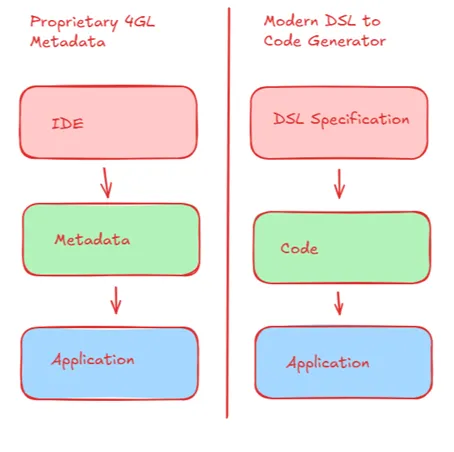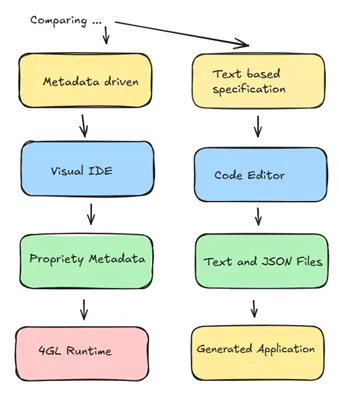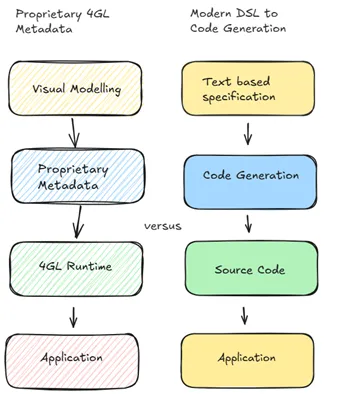Comparative Analysis: 4GL RAD Platforms vs. Modern DSL-Generated Architecture
Technical comparison between established 4GL platforms and modern DSL-based approaches using concrete implementation examples
Published on LinkedIn • Technical Comparative Study
The rapid application development (RAD) platform market presents an interesting study in technological evolution. While established 4GL platforms like Magic xpa continue serving enterprise clients with comprehensive feature sets, emerging DSL-based approaches offer compelling alternatives built on modern architectural principles. This analysis examines the technical merits, deployment characteristics, and long-term maintainability implications of both approaches using concrete implementation examples.
Platform Architecture Comparison
Metadata-Driven vs. Text-Based Specification
Traditional 4GL platforms employ visual modeling environments where business logic resides in proprietary metadata formats. Magic xpa, representing this category, stores application definitions in binary metadata that requires specialized IDEs for modification and debugging.
In contrast, modern DSL approaches use human-readable text specifications that integrate naturally with standard development workflows:
table Manifest {
id Int [pk, increment]
bill_of_lading String [unique]
shipper_id Int [ref: > Client.id]
consignee_id Int [ref: > Client.id]
vessel_id Int [ref: > Vessel.id]
created_at DateTime [default: `now()`]
updated_at DateTime [note: 'Auto-updated']
}
table LineItem {
id Int [pk, increment]
manifest_id Int [ref: > Manifest.id]
commodity_id Int [ref: > Commodity.id]
quantity Decimal
weight Decimal
}
This 15-line specification generates complete SQLAlchemy models, Flask controllers, and web interfaces—functionality equivalent to hundreds of lines of Magic xpa metadata definitions.
 Figure 1: Architecture Paradigm Comparison - Proprietary 4GL metadata vs. modern DSL-to-code generation (image under review)
Figure 1: Architecture Paradigm Comparison - Proprietary 4GL metadata vs. modern DSL-to-code generation (image under review)
Development Environment Analysis
Toolchain Integration
4GL Platform Characteristics:
- Proprietary development environments with specialized debugging tools
- Version control requires platform-specific integration mechanisms
- Team collaboration through shared development databases
- Binary metadata formats preventing direct text-based code reviews
DSL-Based Platform Characteristics:
- Standard development tools (VS Code, IntelliJ, vim) with syntax highlighting
- Native Git integration enabling standard branching and merge workflows
- Human-readable source files supporting conventional code review processes
- Generated output in familiar programming languages (Python, JavaScript)
The implications for team productivity are significant. A shipping management system comparison revealed:
# Generated Python controller (readable, debuggable)
from core.base_controller import BaseCRUDController
from generated.models.shipping_v2 import Manifest
class ManifestController:
def __init__(self, db_session):
self.controller = BaseCRUDController(db_session, Manifest)
self.model = Manifest
def create_routes(self, blueprint):
return BaseCRUDRoutes(
controller=self.controller,
blueprint_name='manifest_v2',
url_prefix='/v2/manifest'
)
This generated controller is immediately comprehensible to any Python developer, contrasting with Magic xpa’s metadata structures that require platform-specific knowledge to interpret and modify.
Deployment Architecture Evaluation
Runtime Dependencies and Scaling
4GL Platform Deployment:
- Requires proprietary runtime licensing for production environments
- Specialized server configurations and deployment procedures
- Platform-specific monitoring and performance optimization tools
- Multi-platform capability (mobile, desktop, web) through unified runtime
DSL-Generated Application Deployment:
- Standard Python/Flask applications with no runtime licensing requirements
- Container-native deployment supporting modern orchestration platforms
- Integration with standard APM tools (New Relic, Datadog) and monitoring systems
- Web-focused architecture optimized for cloud-native scaling patterns
 Figure 2: Deployment Architecture Patterns - Legacy client-server vs. container-native approaches (image under review)
Figure 2: Deployment Architecture Patterns - Legacy client-server vs. container-native approaches (image under review)
A production deployment comparison shows distinct operational characteristics:
Cost Structure Analysis
4GL Platform Total Cost:
- Development environment licensing: $15K-$50K per developer annually
- Runtime deployment licensing: $100K-$500K+ depending on user count
- Specialized training and certification requirements: $10K-$25K per developer
- Professional services premium due to limited consultant availability
DSL-Generated Platform Total Cost:
- Development tools: Standard IDE and hosting costs (~$500-$1000 annually)
- Runtime deployment: Infrastructure costs only (no licensing fees)
- Standard web development skills leveraging existing team capabilities
- Broader consultant and developer availability at market rates
Technical Capability Assessment
Feature Completeness vs. Flexibility
4GL Platform Strengths:
- Comprehensive enterprise modules (reporting, workflow, security)
- Multi-platform deployment with native mobile application generation
- Established integration patterns with enterprise systems
- Professional support contracts with guaranteed service levels
DSL-Generated Platform Strengths:
- Full source code access enabling unlimited customization
- Modern web architecture supporting current UX/UI patterns
- Standard technology stack reducing technical debt and vendor lock-in
- Rapid iteration cycles for business requirement changes
Performance Characteristics
Analysis of equivalent functionality reveals interesting performance trade-offs:
# DSL-generated model with optimized patterns
class Manifest(db.Model):
__tablename__ = 'manifest'
id = db.Column(db.Integer, primary_key=True)
bill_of_lading = db.Column(db.String(255), unique=True, index=True)
# Denormalized fields for performance
shipper_name = db.Column(db.String(255), index=True)
vessel_name = db.Column(db.String(255), index=True)
# Audit trails
created_at = db.Column(db.DateTime, default=datetime.utcnow, index=True)
updated_at = db.Column(db.DateTime, onupdate=datetime.utcnow)
# Relationships with proper eager loading
shipper = db.relationship('Client', foreign_keys=[shipper_id])
line_items = db.relationship('LineItem', backref='manifest', lazy='dynamic')
The generated models include performance optimizations (denormalized fields, strategic indexes, eager loading) that would require manual implementation in either platform but are automatically applied in the DSL approach.
 Figure 3: Performance Scaling Patterns - 4GL runtime vs. modern web application architecture (image under review)
Figure 3: Performance Scaling Patterns - 4GL runtime vs. modern web application architecture (image under review)
Long-term Maintainability Considerations
Technology Evolution Adaptation
4GL Platform Evolution:
- Vendor-controlled upgrade paths with potential breaking changes
- Platform migration requirements for major version updates
- Limited ability to adopt new technologies without vendor support
- Legacy technology debt accumulation over platform generations
DSL-Generated Platform Evolution:
- Generated applications use current web technology standards
- Individual component upgrades possible without full platform migration
- Direct integration of new libraries and frameworks as they emerge
- Technology stack evolution aligned with broader industry trends
Team Knowledge Transfer
4GL Platform Knowledge Management:
- Specialized skills creating knowledge concentration risks
- Limited transferability of platform-specific expertise
- Recruitment challenges due to smaller talent pool
- Training overhead for new team members
DSL-Generated Platform Knowledge Management:
- Standard web development skills with broad applicability
- Generated code serving as documentation and learning resource
- Larger talent pool for recruitment and consulting
- Skills transferable across projects and organizations
Market Segment Suitability Analysis
Enterprise Segment
Large enterprises with complex multi-platform requirements, regulatory compliance needs, and established IT processes continue to find value in comprehensive 4GL platforms. The feature completeness, professional support infrastructure, and proven scalability address specific enterprise requirements that justify the higher total cost of ownership.
Mid-Market Segment
Organizations balancing feature requirements with cost constraints represent the most competitive segment. DSL-generated platforms offer compelling value propositions for web-focused applications, while 4GL platforms provide broader feature sets at higher cost points.
Development-Focused Organizations
Teams with strong technical capabilities and preferences for modern development practices show clear affinity for DSL-based approaches. The alignment with contemporary software development practices (Git workflows, containerization, modern debugging tools) provides productivity advantages that often outweigh feature completeness considerations.
Research Conclusions
The analysis reveals that both approaches serve legitimate market needs with distinct advantages. 4GL platforms excel in feature-complete enterprise scenarios requiring comprehensive functionality and professional support infrastructure. DSL-generated platforms provide superior developer experience and cost efficiency for web-focused applications with teams comfortable extending generated foundations.
Selection Criteria Recommendations:
- Choose 4GL platforms when multi-platform deployment is required, comprehensive enterprise features are needed immediately, and budget accommodates licensing costs
- Choose DSL-generated platforms when web-first architecture is sufficient, development team has strong Python/JavaScript capabilities, and cost predictability is prioritized
The technology evolution trajectory suggests growing opportunities for DSL-based approaches as cloud-native architectures become standard and development teams increasingly prefer modern toolchains over proprietary environments.
Discussion
What has been your experience with 4GL platforms versus modern code generation approaches? Have you encountered specific scenarios where one approach provided clear advantages over the other?
For teams evaluating RAD platforms, what factors have proven most important in your decision-making process—feature completeness, total cost of ownership, or development team preferences?
This comparative analysis is based on production implementations, user feedback analysis, and technical documentation review across both platform categories. Detailed performance benchmarks and cost modeling are available in the complete research documentation.
Tags: #RAPlatforms #EnterpriseArchitecture #TechnicalComparison #4GL #DSL #SoftwareEngineering
Word Count: ~1,150 words
Reading Time: 5 minutes